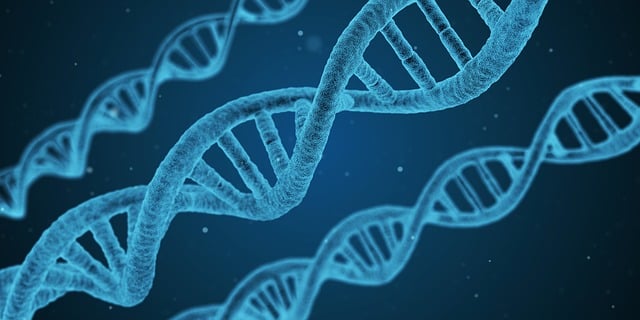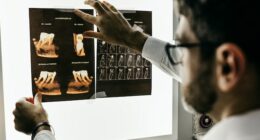Genes refer to specific segments of DNA that carry information for a particular trait or characteristic. DNA is the genetic material present in nearly all living organisms that contains instructions for their development and function.
What are genes?
(Photo by Louis Reed on Unsplash )

Genes are the basic units of heredity that determine inherited traits. They are made up of DNA and carry genetic information from one generation to another. Each gene carries a specific set of instructions for making proteins, which play important roles in various metabolic processes.
Genes are located on chromosomes, which are long strands of DNA found inside the nucleus of cells. Humans have 23 pairs of chromosomes, with each pair containing one chromosome inherited from each parent.
There are different types of genes that control different functions in the body. Some genes code for physical characteristics like eye color, while others regulate metabolism or immune function.
Mutations in genes can lead to genetic disorders such as cystic fibrosis or sickle cell anemia. In some cases, mutations may also increase the risk for certain diseases like cancer or Alzheimer’s disease.
Understanding genes is crucial to our understanding of genetics and human health. By studying how they work and interact with each other, we can gain insight into many complex aspects of biology and medicine.
What is DNA?
(Image by Arek Socha from Pixabay )

DNA stands for deoxyribonucleic acid, which is a long molecule that contains the genetic instructions used in the development and functioning of all living organisms. This molecule is composed of four nucleotide bases: adenine (A), cytosine (C), guanine (G) and thymine (T). These bases form pairs in a specific way; A only pairs with T, while C only pairs with G.
The sequence of these nucleotide bases determines the unique characteristics of each organism. For example, humans have over 3 billion base pairs that make up their DNA code. It’s important to note that not all DNA codes for genes – some regions are non-coding or serve as regulatory elements.
DNA is found inside the nucleus of cells and can also be present in mitochondria. During cell division, DNA replicates itself so that each new cell has an identical copy. Mutations can occur during replication or from environmental factors like radiation exposure or chemical damage.
DNA is a complex yet fundamental component to life on Earth. Its discovery and understanding have revolutionized fields such as genetics and molecular biology.
Genes Vs. DNA – Key differences
Genes and DNA are both fundamental to the study of genetics, but they are distinct concepts with different roles in the genetic makeup of living organisms.
DNA, or deoxyribonucleic acid, is the molecule that carries genetic information and provides the instructions for the development, function, and reproduction of all living organisms. DNA is made up of nucleotides that contain a sugar molecule, a phosphate group, and one of four nitrogenous bases: adenine, thymine, guanine, and cytosine. The sequence of these bases determines the genetic code, which is inherited from parents and passed down through generations.
Genes, on the other hand, are specific segments of DNA that code for a particular protein or trait. Genes are located on chromosomes, which are structures made up of tightly coiled DNA molecules. Each gene contains a specific sequence of nucleotides that provides the instructions for making a particular protein. The proteins made from genes are responsible for various functions in the body, such as enzymes that catalyze chemical reactions, structural proteins that form tissues, and hormones that regulate body processes.
In summary, DNA is the molecule that carries the genetic information, while genes are specific segments of DNA that contain the instructions for making proteins and determining traits.
The role of DNA in the human body
The role of DNA in the human body is fundamental to the development, function, and reproduction of all living organisms. DNA carries the genetic instructions for the production of proteins, which are the building blocks of cells and tissues.
In the human body, DNA is located within the nucleus of cells and is organized into structures called chromosomes. Each chromosome contains many genes, which are specific segments of DNA that provide the instructions for making a particular protein.
The proteins produced by genes play a variety of roles in the body, including:
- Enzymes: Proteins that catalyze chemical reactions in the body.
- Structural proteins: Proteins that provide support and shape to cells and tissues.
- Hormones: Proteins that regulate various body processes.
- Receptors: Proteins that enable cells to respond to chemical signals.
- Transport proteins: Proteins that transport molecules and nutrients throughout the body.
DNA also plays a critical role in the process of cell division, which is necessary for growth, development, and repair of tissues in the body. During cell division, DNA is replicated and passed down from parent cells to daughter cells, ensuring that each new cell has the same genetic information as the original cell.
Furthermore, DNA is also responsible for passing on genetic information from parents to their offspring through the process of reproduction. Variations in DNA sequences between individuals account for the genetic diversity that exists within human populations.
DNA plays a crucial role in the development, function, and reproduction of all living organisms, including humans.
What is the difference between genome and DNA?
DNA is a molecule that carries genetic information in all living organisms, whereas genome refers to the entire set of genetic material within an organism.
DNA is made up of four chemical bases: adenine (A), thymine (T), guanine (G), and cytosine (C). These bases pair up in specific ways to form the rungs of the DNA ladder. The sequence of these base pairs determines the genetic code that instructs cells how to function.
The human genome consists of about 3 billion base pairs, which are organized into 23 pairs of chromosomes. Each chromosome contains many genes, which are segments of DNA that provide instructions for making proteins.
Genes play a crucial role in determining an individual’s traits and characteristics. They influence everything from physical features like eye color and height to susceptibility to diseases like cancer and diabetes.
Scientists have sequenced the entire human genome, allowing them to study genetic variations between individuals and populations. This research has led to new insights into disease prevention, personalized medicine, and evolutionary history.
While both genome and DNA refer to aspects of genetics, they differ in their scope – with DNA being one component within an organism’s larger genome.
Where is gene located?
Genes are located on chromosomes, which are long, coiled-up strands of DNA. In humans, most cells in the body have 23 pairs of chromosomes, for a total of 46 chromosomes. Each chromosome contains many genes, which are specific segments of DNA that provide the instructions for making a particular protein. The location of a gene on a chromosome is determined by its position along the chromosome, and this position can influence how the gene is regulated and expressed. The specific combination of genes inherited from parents determines an individual’s unique traits and characteristics.
What are the types of genes?
There are several types of genes that play different roles in the genetic makeup and function of living organisms. Here are some of the major types of genes:
- Structural genes: These genes provide the instructions for making proteins that are involved in the structure and function of cells and tissues.
- Regulatory genes: These genes control the expression of other genes, either by activating or repressing their transcription.
- Homeotic genes: These genes are responsible for the development of body structures and patterns during embryonic development.
- Oncogenes: These genes can cause uncontrolled cell growth and division, leading to the development of cancer.
- Tumor suppressor genes: These genes help to regulate cell growth and division and prevent the development of cancer.
- Transcription factors: These genes control the transcription of other genes by binding to specific sequences of DNA and activating or repressing their expression.
- Mitochondrial genes: These genes are found in the mitochondria, the organelles responsible for producing energy in cells.
- Epigenetic genes: These genes are involved in regulating gene expression by modifying the structure of DNA or the proteins that interact with DNA.
These are just a few examples of the types of genes that exist in living organisms. Each gene plays a unique role in the genetic makeup and function of an organism.
How many genes do humans have?
The human genome is vast and complex, consisting of over 3 billion base pairs. It’s easy to assume that this would translate to a large number of genes, but surprisingly, humans only have around 20,000-25,000 genes.
This may seem like a small number when compared to the complexity of the human body and its functions. However, it’s important to remember that gene regulation plays a crucial role in determining how these limited numbers of genes are expressed.
Each individual gene can also produce multiple proteins through alternative splicing or post-transcriptional modifications. This means that even with a relatively small number of genes, there is still an incredible diversity in protein expression within any given organism.
It’s worth noting that the exact number of human genes is still somewhat debated within the scientific community due to variations in annotation methods and definitions. However, regardless of the precise number determined by future research efforts, it remains clear that our understanding of the function and regulation of each individual gene will continue to be critical for advancing our knowledge about health and disease.
Featured Image By – Sangharsh Lohakare on Unsplash








